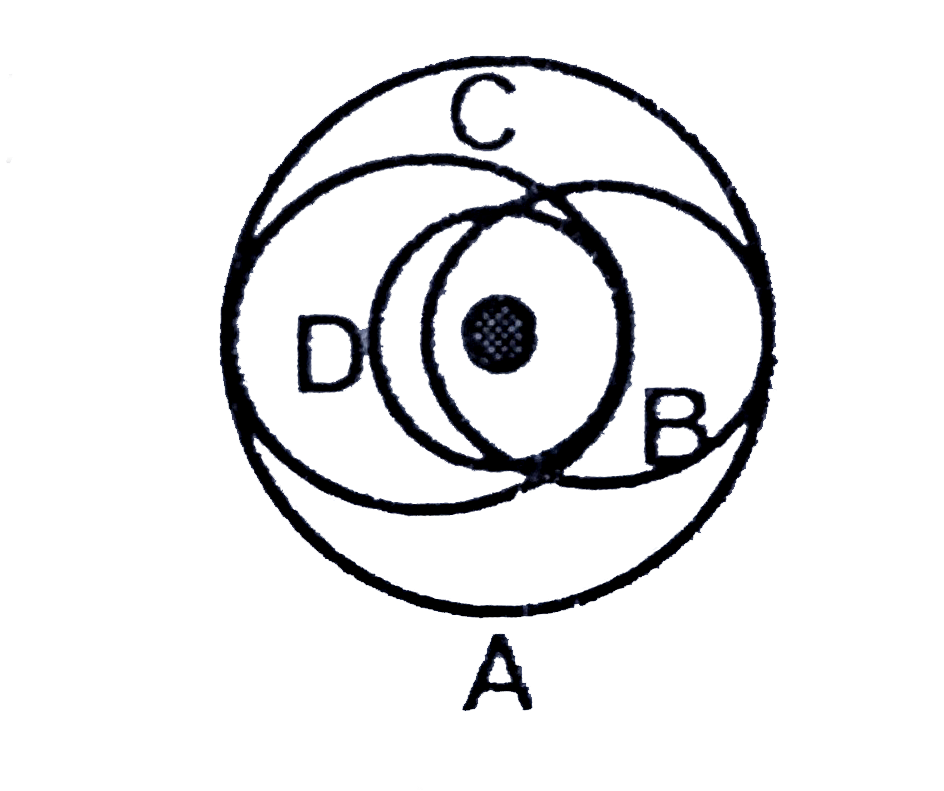In circular orbit of a satellite
orbital speed is √GMr
time period T2∝r3
kinetic energy is GMm2r
potential energy is −GMm2r
The correct Answer is:A, B, C
To solve the question regarding the properties of a satellite in circular orbit, we will analyze each statement provided in the options and derive the necessary formulas step by step.
Step 1: Understanding the Forces Acting on the Satellite
In a circular orbit, a satellite is subject to two main forces:
1. The gravitational force acting as the centripetal force.
2. The centripetal force required to keep the satellite in circular motion.
Step 2: Equating Gravitational Force and Centripetal Force
The gravitational force Fg acting on the satellite is given by:
Fg=GMmr2
where:
- G is the universal gravitational constant,
- M is the mass of the planet,
- m is the mass of the satellite,
- r is the distance from the center of the planet to the satellite.
The centripetal force Fc required to keep the satellite in circular motion is given by:
Fc=mv2r
where v is the orbital speed of the satellite.
Setting these two forces equal gives us:
GMmr2=mv2r
Step 3: Solving for Orbital Speed
We can simplify this equation by canceling m (assuming m≠0) and multiplying both sides by r:
GMr=v2
Taking the square root of both sides, we find the orbital speed v:
v=√GMr
This confirms that the first option, v=√GMr, is correct.
Step 4: Deriving the Time Period
Using Kepler's Third Law, we know that the square of the time period T of a satellite is proportional to the cube of the radius of its orbit:
T2∝r3
This means that the second option is also correct.
Step 5: Calculating Kinetic Energy
The kinetic energy KE of the satellite can be expressed as:
KE=12mv2
Substituting the expression for v2 from earlier:
KE=12m(GMr)=GMm2r
Thus, the third option is correct.
Step 6: Calculating Potential Energy
The gravitational potential energy U of the satellite is given by:
U=−GMmr
However, the option states it as −GMm2r, which is incorrect. Therefore, the fourth option is incorrect.
Conclusion
The correct options are:
- Option A: Correct
- Option B: Correct
- Option C: Correct
- Option D: Incorrect
In a circular orbit, a satellite is subject to two main forces:
1. The gravitational force acting as the centripetal force.
2. The centripetal force required to keep the satellite in circular motion.
The gravitational force Fg acting on the satellite is given by:
Fg=GMmr2
where:
- G is the universal gravitational constant,
- M is the mass of the planet,
- m is the mass of the satellite,
- r is the distance from the center of the planet to the satellite.
Fc=mv2r
where v is the orbital speed of the satellite.
GMmr2=mv2r
We can simplify this equation by canceling m (assuming m≠0) and multiplying both sides by r:
GMr=v2
Taking the square root of both sides, we find the orbital speed v:
v=√GMr
This confirms that the first option, v=√GMr, is correct.
Using Kepler's Third Law, we know that the square of the time period T of a satellite is proportional to the cube of the radius of its orbit:
T2∝r3
This means that the second option is also correct.
The kinetic energy KE of the satellite can be expressed as:
KE=12mv2
Substituting the expression for v2 from earlier:
KE=12m(GMr)=GMm2r
Thus, the third option is correct.
The gravitational potential energy U of the satellite is given by:
U=−GMmr
However, the option states it as −GMm2r, which is incorrect. Therefore, the fourth option is incorrect.
The correct options are:
- Option A: Correct
- Option B: Correct
- Option C: Correct
- Option D: Incorrect
Topper's Solved these Questions
Similar Questions
(a).Find the radius of the circular orbit of a satellite moving with an angular speed equal to the angular speed of earth's rotation. (b). If the satellite is directly above the north pole at some instant, find the time it takes to come over the equatorial plane. Mass of the earth =6×1024kg
View SolutionSTATEMENT-1: Radius of circular orbit of a satellite is made two times, then its areal velocity will also becomes two times.
because
STATEMENT -2 : Areal velocity is given as dAdt=L2m=mvr2m.
View Solution
Knowledge Check
Two satellites are revolving around the earth in circular orbits of same radii. Mass of one satellite is 100 times that of the other. Then their periods of revolutions are in the ratio
A1:1B10:1C100:1D1:100
The radii of circular orbits of two satellite A and B of the earth are 4R and R, respectively. If the speed of satellite A is 3v, then the speed of satellite B will be
View SolutionThe circular orbit of two satellites have radii r1 and r2 respectively (r1<r2). If angular velosities of satellites are same, then their centripetal accelerations are related as
View SolutionStatement I: Two satellites are following one another in the same circular orbit. If one satellite tries to catch another (leading one) satellite, then it can be done by increasing its speed without changing the orbit.
Statement II: The energy of earth-satellite system in circular orbit is given by E=(−Gms)/(2a), where r is the radius of the circular orbit.
View SolutionSuppose the force of gravitation is inversely proportional to the cube of the radius of circular orbit in which satellite is revolving then its time period is proportional to
View SolutionThe total energy of a circularly orbiting satellite is
View SolutionThe given figure shows several possible elliptical orbits of a satellite. On which orbit will the satellite acquire the largest speed ?

View SolutionAn earth satellite is moving round the earth in a circular orbit . For such a satellite which of the following statement is wrong ?
View Solution
